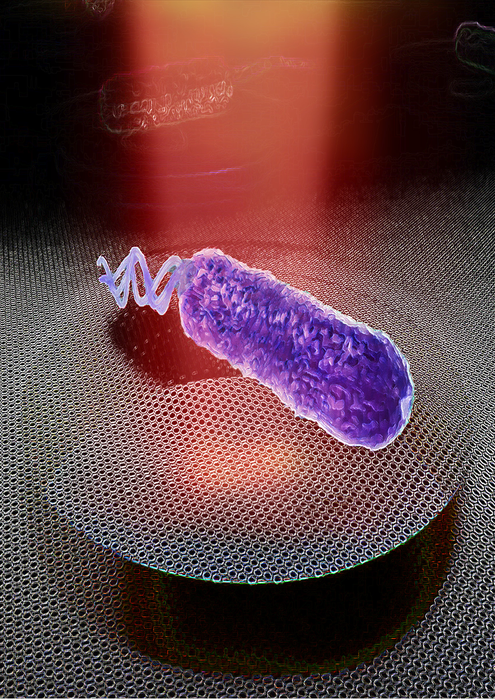Ever wondered if bacteria produce distinct sounds? By listening to bacteria, it is possible to judge if they are alive or not. The bacteria would stop making such sounds if they were to be killed with an antibiotic — unless the bacteria were resistant to the antibiotic.
 Artist’s impression of a graphene drum detecting nanomotion of a single bacterium. Image Credit: Irek Roslon, Delft University of Technology.
Artist’s impression of a graphene drum detecting nanomotion of a single bacterium. Image Credit: Irek Roslon, Delft University of Technology.
This is precisely what a team of TU Delft researchers led by Dr. Farbod Alijani has now accomplished. The researchers used graphene to capture low-level noise in a single bacterium. Their findings have been published in the journal Nature Nanotechnology.
The Sound of a Single Bacterium
Initially, Farbod Alijani’s team was interested in the fundamentals of graphene mechanics, but they became curious about what would happen if this highly sensitive material came into contact with a single biological object.
Graphene is a form of carbon consisting of a single layer of atoms and is also known as the wonder material. It’s very strong with nice electrical and mechanical properties, and it’s also extremely sensitive to external forces.
Dr. Farbod Alijani, Delft University of Technology
The investigators began working with Cees Dekker’s nanobiology group and Peter Steeneken’s nanomechanics group. The team conducted their first experiments with E. coli bacteria with the help of Ph.D. student Irek Roslon and postdoc Dr. Aleksandre Japaridze.
What we saw was striking! When a single bacterium adheres to the surface of a graphene drum, it generates random oscillations with amplitudes as low as a few nanometers that we could detect. We could hear the sound of a single bacterium!
Cees Dekker, Delft University of Technology
Punching a Graphene Drum with a Bacterium
The incredibly small oscillations are a result of the bacteria’s biological processes, with their flagella playing a major role (tails present on the cell surface that propels bacteria).
“To understand how tiny these flagellar beats on graphene are, it’s worth saying that they are at least 10 billion times smaller than a boxer’s punch when reaching a punch bag. Yet, these nanoscale beats can be converted to sound tracks and listened to—and how cool is that,” remarked Alijani.
Graphene for Fast Detection of Antibiotic Resistance
This study has far-reaching implications for detecting antibiotic resistance. The results of the experiment were clear: if the bacteria were resistant to the antibiotic, the oscillations simply continued at the same level. Vibrations reduced until one or two hours later when the bacteria were sensitive to the drug, but then they were completely gone. The phenomenon can be detected with just a single cell thanks to the high sensitivity of graphene drums.
For the future, we aim at optimizing our single-cell graphene antibiotic sensitivity platform and validate it against a variety of pathogenic samples. So that eventually it can be used as an effective diagnostic toolkit for fast detection of antibiotic resistance in clinical practice.
Dr. Farbod Alijani, Delft University of Technology
“This would be an invaluable tool in the fight against antibiotic resistance, an ever-increasing threat to human health around the world,” concluded Peter Steeneken.
Journal Reference:
Rosłoń, I. E., et al. (2022) Probing nanomotion of single bacteria with graphene drums. Nature Nanotechnology. doi.org/10.1038/s41565-022-01111-6.